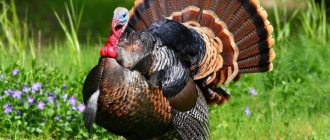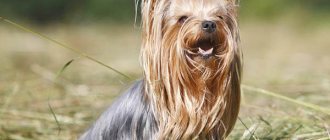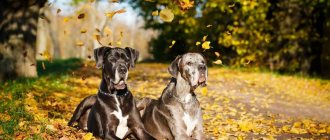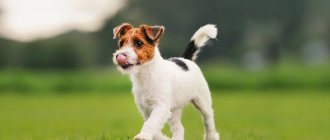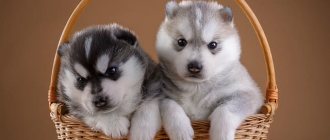Review author: “ZooVita”
This sweet, good-natured dog is an excellent companion and an indispensable assistant to hunters. Those who love long walks and trips to the bosom of nature will be ideal owners for it, but homebodies will only experience inconvenience.
Smart, quick-witted individuals will not annoy with causeless noise; they have a silent and patient disposition. A smart earner, a faithful family friend, he is responsive to affectionate treatment, coping with any master’s assignment, for this it is enough to bestow him with human attention.
Description of the Golden Retriever breed
Popularity 211th place among 263 dog breeds
Lifespan:
11-13 years old
Breed group:
Service
Height:
males: 56-61 cm, females: 51-56 cm
Country of origin:
Great Britain
Average price:
25-35 thousand rubles
Weight:
males: 26-41 kg, females: 25-37 kg
Latest articles Cat health
Ataxia in cats: what is it, how does it manifest and is treated 01/23/2022 180 0 0
Cat health
Leukemia, or viral leukemia in cats 01/23/2022 156 0 0
Curly-coated (curly-coated)
In general, it was the Curley that officially appeared before the Golden - according to some sources, back in the sixteenth century. However, dogs of that time did not fit modern standards at all.
Curley was the result of crossing a Newfoundland and an Irish Water Spaniel. But already at the end of the nineteenth century, poodle blood was added, which changed the appearance of the dogs and also improved the quality of the coat.
Curley is the largest among retrievers - the height of females is about 62 cm, and males - 68 cm.
Key facts
Golden retrievers are very hardy and energetic. They are very smart, agile, friendly, a little intrusive, but only because of their boundless love and boundless devotion to their owner. The main distinguishing features included in the description of the Golden Retriever breed are a good memory and a keen sense of smell, thanks to which the dogs are brilliant detectives and hunters.
It is not difficult for them to find game in high thickets, deftly catch it and hold it. With proper, timely training, puppies grow into excellent guides, detectives, and professional rescuers. They are very active, playful, love walks, active entertainment, as well as long journeys with their beloved owners.
Golden retrievers are truly loyal friends who also perfectly perform the role of “nannies” - they love to tinker and play with kids. However, there are also exceptions, it all depends on the character of the dog.
In the characteristics of the Golden Retriever breed, the coat is a calling card, which, unfortunately, causes great inconvenience. You'll have to love cleaning with these fluffies, because they shed a lot. These pets are definitely not suitable for allergy sufferers.
Animals of this breed are great lovers of water. It doesn’t matter to them whether it’s a large lake, a swimming pool or an ordinary dirty puddle. During a rainy walk, you should avoid the latter - otherwise you will have a long wash. But with the onset of warm seasons, go to ponds or rivers. Swimming for such shaggy animals is a kind of emotional release.
Also, these beauties are very photogenic, stately, beautiful, and love a lot of attention. Therefore, retrievers can often be found in films about a typical wealthy American family or in some advertisements for luxury food.
The health and life expectancy of the Golden Retriever are at the level of the golden mean: with proper care, the dogs feel good and celebrate their 12th birthday.
Health Features
Almost all representatives of the breed are characterized by good health and immunity. This allows them to live up to 12 years, but proper care, nutrition and good health will allow four-legged pets to live up to 16 years. In the history of this breed, such cases of longevity have been recorded.
The development of dangerous diseases can be prevented through timely vaccination with foreign drugs. Also, the owner of the animal must remember about regular deworming and treating the skin with anti-parasite agents.
History of the origin of the golden retriever
English aristocrats are passionate fans of hunting. In the 19th century, similar events involving baiting, catching game, and shooting birds were common among the British and Scottish secular elite. Going into the forests and swamps for several days, the venerable sirs boasted to each other about their guns, trophies, thoroughbred horses and dogs.
However, at that time there was a lack of truly fast, dexterous four-legged hunters capable of any forays after prey through tall thickets or difficult water obstacles. Thus, a huge demand has developed for pets with pronounced hunting characteristics.
According to one version, in the 1860s, a certain Lord Tweedmouth acquired Russian Shepherds at a circus performance and began breeding new species through mating and crossing. But these were just rumors created by the aristocrat himself in order to attract the interest of others to his person. After some time, it turned out that the golden beauties have completely different roots.
In the 1940s, then-famous dog handler Elma Stoneks, using Lord's records from the 1860s to the 1890s, revealed the real family ties of the new dogs. The animals have the genes of Labrador, Bloodhound, “water” tweed spaniel and black retriever. After numerous matings, the pets acquired their own special color, became more resilient, active and intelligent, and also ceased to be afraid of water.
In the 1920s, goldens were distributed throughout the West, in the United States, and Canada. Overseas, dogs with a rich, dark-golden coat were more valued. In the 1960s, the breed was officially recognized and registered according to all standards.
Their descendants appeared in Russia only in 1989. Alexey Surov brought them from the USA. And in the 1990s, after the collapse of the Soviet Union, the first Russian retriever puppy was born.
History of the breed
North America is considered to be the homeland of Labradors, where dogs helped people in fishing, nursed children and acted as guides for the blind. In 1830 they were brought to Britain by sailors. British families appreciated the intelligence and understanding of dogs with whom they could go hunting and fishing, trust their children with them and not worry about other pets, with whom Labradors got along well.
NOTE!
In 1903, the official Kennel Club of England gave the official name to the breed - “Labrador”. In 1941, the Labrador Club of Scotland was opened by a descendant of Walter Scott - the current Duke of Buccleuch. The inhabitants of this prestigious nursery have not lost their recognition to this day as the ancestors of the main lines of the breed.
As time passed, the Labrador's talent for hunting gave way to successful demonstrations at exhibitions.
In this regard, this breed has subtypes:
- show;
- workers;
- dual purpose dogs.
Appearance of a Golden Retriever
General impression
Goldens are very beautiful, stately dogs with heavy, shiny, smooth fur, white teeth and expressive eyes. They have a strong muscular frame and a strong, gripping mouth. Intelligence and kindness are visible even in photos of golden retrievers.
There are three types of retrievers:
- English;
- American;
- Canadian.
American quadrupeds are distinguished by the darkest color, English (European) ones are slightly lower and stockier than their relatives. This type is common in our country. Among all three types, Canadian representatives are the tallest and slender.
Head
The shaggy beauties have a massive, convex skull shape, a clear, smooth transition line from the forehead to the nose. Their cheekbones are visible, and their muzzle is elongated and smooth. The back of the head has a slightly protruding smooth tubercle.
Neck
There are no folds on the neck. She is quite massive with strong muscles and a high, medium-length stance.
Torso
The body of animals is fit, strong, with prominent muscle mass. Flat back with a slight curve at the lower back. The withers are clearly defined. The croup is round, medium in size with a slight slope. The chest is of moderate width. The area at the bottom of the abdomen is well toned.
Forelegs
The front paws are very strong, strong, they perform an important shock-absorbing function. When jumping upward, most of the weight, and therefore the load, is transferred to these parts of the body. Muscular shoulder frame, smooth and strong forearms. By standards, the shoulder blades are equal in length to the shoulders. The elbows are located close to the body. The pasterns are rather short with a smooth, slightly oblique curve.
Hind limbs
The hind limbs have a more complex structure than the forelimbs, despite the fact that they take on less load. The legs are located at a wide distance from one another. The joint bends are low. The paws have a slightly rounded shape, this helps them land softly on the ground and not get tired for a long time, for example, when running long distances.
Tail
By standard, the tail is straight and in line with the back. It has a medium length, a wide base, and a slightly elongated cone-shaped end. In a normal, calm state, the tail is at a low level; in an excited, excited or joyful dog, it is raised to the level of the back.
Movements
The pet's movements are confident, with a quick response to commands or some external stimuli. While running, the paws are freely and easily thrown forward, making smooth swings. From birth, the animal should be taught to behave carefully around humans, because they are very strong, heavy, and can sometimes make sudden, unexpected, possibly dangerous movements for humans.
Wool
The wool is heavy, but very pleasant, soft, smooth to the touch. It has the property of repelling water. The undercoat is very massive, it is hidden by strong, thick hair that fits tightly together. Their structure can be either straight or slightly wavy. Most hair is on the chest, lower abdomen, ears, and lower part of the tail.
Color
Golden Retriever colors can range from light cream tones to dark brown or bright gold. There may be a few white hairs on the chest.
Size
Golden Retrievers are large in size and have an elongated body. The length of the body, including the tail, of an adult male is approximately 80 cm. The body is proportional. The above description of appearance and parameters refers to exterior standards.
These pets clearly show sexual typing. Males are much larger, stockier, taller, and heavier than females. Thus, the average weight of a male golden retriever is 35 kg with a height of about 60 cm, while a female with an average weight of 30 kg has a height of 53 cm.
Being too large or too short in stature for a Golden Retriever is considered a disqualifying fault. Judges are stricter with females.
Chesapeake Bay Retriever
The most non-standard of the six Retrievers. Firstly, his homeland is the USA, more precisely, the state of Maryland, whose official symbol it is now. Secondly, its body shape differs significantly from the standard: a large, heavy neck for lifting heavy game, a straight top line for fast swimming, high-set ears so that the dog does not catch a cold in icy water.
The dogs have a short, wavy, plush coat with a padded undercoat. This cover provides excellent protection from the cold. Webbed feet allow them to swim long distances. And the color of the cover gives good camouflage. At the withers, the Bay Retriever can reach 66 cm, maximum weight – 36 kg.
This is the most independent Retriever; it may seem that he is cold towards his family and does not like to play. But in fact, the Chesapeake is loyal to its owners, but is not used to showing its emotions in public.
The breed is non-aggressive, treats children and animals well, but does not like large dogs, responds in kind to anger, and knows how to stand up for itself. Such a pet needs a strong leadership hand and serious education with a course of socialization, otherwise the pet will be tense and timid. The average cost of a puppy is 30,000 rubles .
All Labradors are wonderful pets: kind, active, affectionate, efficient. These are smart dogs, easygoing and non-aggressive. But you should not think that such a character does not need tempering and education.
5 / 5 ( 1 voice )
Personality of the Golden Retriever
The main behavioral features are boundless devotion to humans, the ability to charm with one’s good nature, tolerance, as well as neatness and gentleness, which is unusual for large animals. Golden retrievers require affection, communication, and constant attention. Therefore, when leaving home for a long time, know that your friend will miss you terribly, and upon his return he will give you a lot of enthusiastic emotions. The character of the Golden Retriever is distinguished by sociability, love for children, and mental stability. This is a great friend for the whole family. Some dog breeders call them big beasts with the personality of a tiny, sweet puppy.
Furry friends are able to perfectly read a person’s state. At the right time, they help relieve emotional stress. Your personal shaggy “antidepressant” will spend time with you with great pleasure, charge you with a lot of positive impressions, and calm you down. However, their good nature extends to all people, so to protect your home it is better to get another dog, but with a more severe character.
These dogs are sanguine, they are not inclined to dominate. Get along well with other pets. Their favorite activities are any active games, walks, jogging, swimming and much more related to active activities. They are characterized by quick wit, intelligence, and some delicacy in behavior.
Pros and cons of the breed
| + | – |
| Faithful and devoted friends | They shed profusely |
| Beautiful hunting dogs | Not suitable for the role of watchman |
| Suitable for apartment living | Are happy to make contact with a stranger |
| Compatible with cats and other animals | Prone to cancer |
| Great with children | Have a short lifespan |
| Suitable for active owners | Requires patient training |
Golden Retrievers are ideal family dogs. They cannot live without communicating with people, they are very vulnerable. This breed requires affection, love and patience. They are distinguished by their delicacy: they will never impose their company. They enjoy playing with their relatives and other animals and adore children. Suitable for active owners who can devote enough time to the dog and pay for medical care.
Education and training
The very first and very important point is to teach him to obey you: prohibit him from jumping on his hands, pushing him in the back with his paws. At a small age, such habits are funny, but with a large dog they are quite dangerous for humans, especially for children.
The second step is the “fu” command. After all, goldens are big fans of trying everything around, any thing that arouses even the slightest interest.
As soon as the puppy begins to show the rudiments of a hunter and detective, try to go out into nature with him more often, organizing an impromptu hunt in the form of a game. If you continue to learn hunting skills, your furry will grow into an excellent, fast bloodhound.
From six months old, puppies learn to row well in the water. From the age of twelve months, it is optimal to start training endurance, since an ambush during a hunt requires a clear understanding of this lesson. Raising and training a Golden Retriever will bring a lot of pleasure to both owner and dog.
Reproduction and lifespan
This is not to say that golden retrievers do not live long. Usually, with good care, they live up to 12-13 years. To make the animal feel comfortable, it is recommended to feed it properly, take it to nature, play sports with it, etc.
The breeder of the breed is required to have accurate knowledge about it. He should not confuse the European and American retrievers. Only representatives of one group should be brought together. Dogs are bred in the male's territory.
This is usually done in the middle of the female's estrus period. A pregnant golden bitch becomes even more affectionate than she was before. Over the course of 70 days (plus/minus 3 days), she will especially need the attention of the owner breeder.
Golden Retriever Health and Diseases
Possible diseases
Goldens get sick quite often and are one of the regular patients of veterinary clinics. The main problem is usually excess body weight, which causes arthritis. Other possible diseases:
- epilepsy (fits, convulsions);
- von Willebrand disease (gums, nose, genitals bleed);
- hip dysplasia (loose joint condition);
- retinal atrophy (possible blindness);
- dermatitis (skin inflammation), etc.
But do not be afraid of the above list, because all these diseases can be gradually eliminated if they are identified in the early stages, with a competent approach, and comprehensive proper treatment.
Reproductive health
Females mature quite early - the first estrus occurs at 8-12 months of life. But her fragile body is not yet ready for pregnancy and childbirth, so postpone mating until she reaches 20 months of age.
It’s the same story with male dogs: even if he begins to settle down, this is not a signal for the beginning of his sexual life. It is necessary to wait a year and a half and then carry out the first mating.
Pregnancy and childbirth in a female are quite easy; at 2-3 weeks you can notice the first signs, including toxicosis. In the second half of pregnancy (30 days after mating), you can start feeding the bitch more often and in larger portions.
Labrador
Different colors are acceptable for Labradors.
Often, beginners want to know everything about the types of Labradors. And this is the wrong way to pose the question - in fact, there is only one breed - the Labrador Retriever. Therefore, the question of what types of Labradors there are is very incorrect.
It was developed in Canada in the nineteenth century. Breeders mixed several dog breeds at once - a small Newfoundland, a setter, a curly-haired retriever and an English foxhound. As a result of this mixture, the Labrador appeared - a type of retriever breed.
For reference! The standard was established at the end of the nineteenth century, namely in 1887.
Initially, this American dog had a strict color restriction. The Labrador's coat had to be black. But over time, fawn and then chocolate colors were also allowed. But, of course, these are not separate varieties of Labradors, but simply different colors of one.
Labradors are relatively small in size - males are about 56-57 cm tall and weigh 29-36 kg, while females are smaller - about 54-56 cm and 25-32 kg.
Features of feeding and diet
Feeding your four-legged friend is allowed with both industrial feed and homemade food. It is important to feed your dog after a walk, not before it. The animal must not be overfed. Frequent feeding and too much daily calorie intake have a negative impact on health and lead to various diseases.
When composing your diet, you should adhere to certain rules.
Half of the diet must consist of a sufficient amount of protein products; Lean varieties of beef, rabbit, and turkey are suitable. By-products are also acceptable, but in small proportions. The daily norm of meat is 10-20 grams per 1 kilogram of body weight.
The other 50% of the daily menu consists of complex carbohydrates, that is, cereals: buckwheat, rice, and so on. It is better to cook thick, rich porridges from them, adding various fresh or thermally processed vegetables. The most useful root vegetables are carrots, beets, cabbage, and turnips. Fermented milk products are needed for the normal functioning of the animal’s digestive tract, so kefir, cottage cheese, and yogurt can be given periodically.
As for the nutrition of babies, it is recommended to give them whole milk until they are twelve months old, and sometimes add it to porridge. According to the instructions of veterinarians, up to four months of age, it is necessary to feed fractionally five times a day. From four months there is a transition to feeding four times a day. At the age of six months - three meals a day, and from eight months - two standard feedings a day.
Nutrition
It is possible to feed golden retrievers with dry industrial food or natural food. Industrial feed should be of premium quality, containing sufficient amounts of meat, vitamins and minerals. This will help make his coat shiny and shiny.
Natural nutrition should consist of:
- vegetables (carrots, potatoes, turnips);
- sea fish without bones;
- porridge (buckwheat, oatmeal, millet);
- fruits (bananas and apples);
- fermented milk and dairy products (yogurt, cottage cheese, kefir);
- lean meat (poultry, veal, beef);
- boiled offal;
- bones;
- a small amount of butter.
It is forbidden to give golden retrievers:
- raw and fatty meat;
- bird bones (tubular);
- smoked meats;
- offal without heat treatment;
- spices and seasonings;
- fried foods;
- sweets.
If you choose natural nutrition, you will definitely need to include mineral and vitamin supplements.
Care and maintenance
The ideal living environment would be a house in the countryside. Retrievers are very active, curious, and love hunting. In apartment conditions, they need sufficient time to walk outside the home.
It is important to walk your retriever at least two hours a day. Babies up to four months of age are carried outside in their arms and brought into the house in the same way. You should take them for walks more often in order to teach them to use the toilet outside.
In general, frequent walks quickly adapt your pet to other people, nature, outside noise from cars and other things.
It is better to bathe once or twice a month, using special detergents and conditioners. The main problem for the owner of the dog is its long hair, which needs timely and proper care: thorough washing, combing with a brush, which can be purchased at any pet store.
Every week it is recommended to examine the eyes, ears, mouth, and paw pads. Ears should be washed and cleaned as necessary. It happens that your furry friend himself will hint to you about this, constantly scratching his ears or shaking his head.
To prevent the appearance of dark plaque and tartar, you should give your pet special bones, and brush your teeth with a fingertip every three days. In general, caring for and maintaining a Golden Retriever does not take much time and is no different from maintaining other dog breeds.
Buying a dog
When choosing a puppy, the first thing you need to decide is for what purpose it is needed: for hunting, shows, trials, or just for comfort and warmth in the family.
What should you pay attention to when buying a retriever?
- The puppy should be friendly, agile, not overactive or lethargic;
- The coat should be free of signs of parasites;
- The room in which puppies are kept must be warm, clean and free of foreign odors;
- When meeting, dogs should wag their tails.
If a puppy is purchased as a pet, the optimal age for purchasing it is 7-7.5 weeks . It is not recommended to move a puppy into a new environment at 8 weeks, as during this period he is especially sensitive to change. It's better to wait until 9 weeks.
Important! A Golden Retriever without a pedigree often turns out to be either a mixed breed or a very sick dog.
When buying a show puppy you need to be more careful. First, you need to study all the breed standards, which will become a guide in choosing a particular puppy. It would be a good idea to visit specialized exhibitions and talk with breeders who are exhibiting.
Some believe that the breeder will certainly keep the best puppies for himself. It's a delusion. Even the most active caregivers will be happy to give the puppy into the hands of people interested in showing and winning. It is imperative to request a pedigree, photographs, and a detailed description of the dog.
Buying an adult dog
Changing the owner and habitual habitat for a golden retriever is a lot of stress. Therefore, it is important that the previous owner himself brings the pet to the new home and helps him adapt a little. To speed up this process, it is recommended to place some object familiar to him in the place where the pet will sleep.
There is an undoubted advantage in buying an adult dog - complete confidence in its beauty and qualities. This is especially true when purchasing show dogs.
Preparing your home for a puppy
Before purchasing a puppy you must:
- Hide potentially dangerous items (tools, cords, small toys, chemicals, cleaning products);
- Remove plants that are dangerous to the puppy’s health (dieffenbachia, aucuba, spurge, cucumber, ficus, pasalia, holly, wisteria, cyclamen);
- Consult your veterinarian about the best food for your puppy;
- Ensures the availability of fresh water at any time;
- Prepare a sleeping place:
- Place a toilet (tray with filler) in the house.
Price of puppies
Factors influencing the price:
- Age (the older the puppy, the higher the price);
- Health status;
- Pedigree.
It is worth noting that domestic puppies will cost less than promising show puppies from the same litter. The price, depending on the above factors, ranges from 250 to 5000 dollars .
Tips for choosing a puppy
If you decide to get a furbaby, choose responsible sellers. The ideal option is to contact a breeding nursery with a good reputation. Golden Retriever puppies from private breeders may be not purebred or carry diseases.
Observe the puppy’s behavior for some time: how it eats, plays, and behaves with other pets. Find out about the health status of the parents, especially the mother during pregnancy. Any complications during gestation can lead to the development of pathologies in small animals, including hydrocephalus (impaired circulation of the fluid that washes the brain).
The characters of retrievers are different: American ones are more energetic, while European ones are graceful and less emotional. This should also be taken into account when choosing. When registering, you are required to provide all documents: pedigree certificates, veterinary certificates, characteristics.
Of course, when choosing, it is important to trust your heart. As a rule, one glance is enough to understand that that same little friend is yours forever!
How to choose a puppy
- When going to the nursery, arm yourself with a printout of the breed standard, or better yet, take with you a specialist who will help you choose a puppy. If this is not possible, contact any of the kennel clubs, where they will recommend you a reliable breeder.
- Puppies inherit from their parents not only their appearance and hunting qualities, but also their temperament type, so when talking with the seller, insist on getting to know the mother and father of the babies. If such a favor is refused to the buyer, there is a high probability that the pedigree of the dogs is so-so.
- For those who see a future family friend in a golden retriever, it is better to purchase bitches that are more docile and affectionate. Golden males are distinguished by their bright charisma, but their character is more serious and firm. In addition, boys are much smarter when it comes to hunting.
- The temperaments of American and European retrievers differ significantly - take this fact into account when buying a puppy. Goldens from the USA are more energetic and emotional. Native “Europeans” are noticeably more phlegmatic and do not suffer from hyperactivity.
- Responsible breeders who value their own name have puppies that are well-groomed, vaccinated and treated with anthelmintics.
How much does a golden retriever cost?
The approximate cost of a pet-class puppy is from 20 to 25 thousand rubles. The price of a golden retriever for a class show is usually in the range from 35 to 50 thousand rubles. Dogs of this group have all the parameters necessary for competitions. Their belonging to the clan is 100% guaranteed. In addition to this price group, there is an even more expensive class costing from 65 to 80 thousand rubles. Such animals are born from interbreeding. In the future, this makes it possible to breed purebred puppies and sell them for a good profit.
Do you like the article? 0
Diseases
From the description of the Golden Retriever, it is clear that he is a cheerful, active, energetic animal, but as a result of hereditary predisposition he may suffer from:
- retinal degeneration;
- hip dysplasia;
- oncology;
- hypothyroidism;
- heart ailments.
In addition, there is a risk of obesity, arthritis and dental inflammation. Annual vaccination is required.
Key points in training
From the first days a puppy appears in the house, it is worth accustoming it to a feeding and walking regime . You also need to show that the person is in charge in order to discourage the pet from being wayward. For incorrect behavior, the dog is punished: deprived of treats, toys or food. Rude and violent methods are not effective.
By 3-4 months, the puppy should know its name and be able to walk on a leash. From this age you can start learning commands. One of the options is a training school, where dog handlers will teach the dog all the necessary rules of behavior. But retrievers are quite easy-going and do not require particularly strict training.
Basic commands required for Golden:
- "Near";
- "Place";
- "It is forbidden";
- "Voice";
- "Quiet";
- "Sit";
- "Lie".
From 5-6 months you can take part in agility (obstacle course).
Read about how to properly train a dog in the article: “Training a puppy: effective methods from dog handlers, learning commands at home.”
Straight-haired
Like many of the best dog breeds, it was bred in Great Britain. It combines the genes of a Labrador Retriever, an English Pointer and an Irish Setter. Thanks to this, the dog swims superbly, has excellent sense of smell and works well on the hunt.
Curious! The second name of the breed is smooth-haired retriever or flat.
Compared to other representatives of the section, this type seems more lanky. With the height of males 59-62 cm at the withers and females 56-59, they weigh about 27-36 and 25-32 kg, respectively.
The dog gained particular fame during the First World War - it was actively used for various official purposes, from searching for mines to detaining spies. However, in recent years they can also often be seen as guide dogs, companion dogs, and also in tracking work.
Differences in retrievers by color
Of course, all types of retrievers are similar breeds. But they still have certain differences. To begin with, the colors allowed here are very diverse. What is standard for one breed will be a waste for another.
For example, a Labrador can be black, roan, or chocolate. But for goldens, only golden or cream color is acceptable.
Chesapeake Bay is very different - the color of withered grass is most valued, but any shades from light straw to dark brown are not considered rejects.
